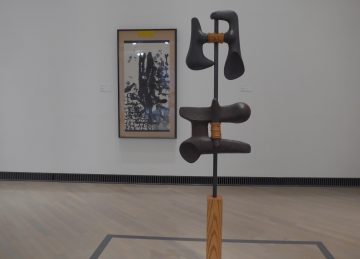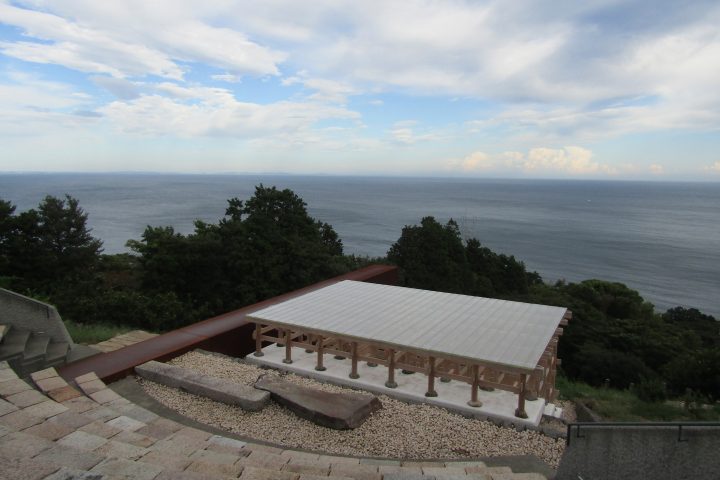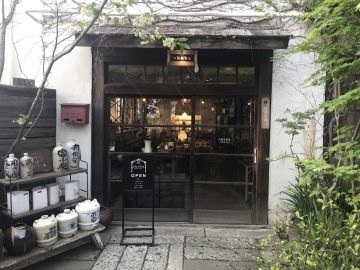Thoughts on the Next Venice Biennale - An Interview with Shiota Chiharu and Nakano Hitoshi
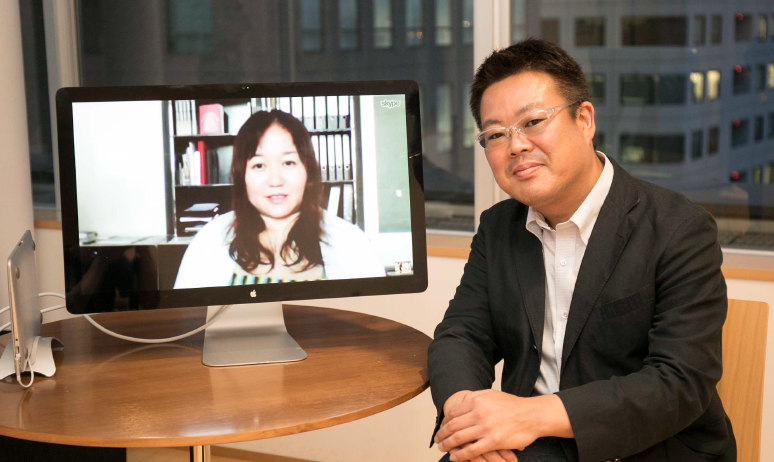
Chiharu SHIOTA
Born in Osaka Prefecture in 1972. Lives in Berlin. Confronting the fundamental human problem of life and death, he creates large-scale installations, exploring the questions of "what is life" and "what is existence," and using a variety of techniques including sculpture, photography, and video. He won the Minister of Education, Culture, Sports, Science and Technology's Art Encouragement Prize for New Artists for his solo exhibition "From Silence" (2007) at the Kanagawa Prefectural Hall Gallery. His major solo exhibitions include the Kochi Museum of Art (2013), Marugame Genichiro-Inokuma Museum of Contemporary Art (2012), Casa Asia (Spain, 2012), and the National Museum of Art, Osaka (2008). He has participated in numerous international exhibitions, including the Kiev International Biennale of Contemporary Art, the Setouchi Triennale, the Aichi Triennale, the Moscow Biennale, the Seville Biennale (Spain), the Gwangju Biennale (Korea), and the Yokohama Triennale. He was appointed a cultural envoy by the Agency for Cultural Affairs (2012) and visited Australia.
Hitoshi Nakano|Hitoshi Nakano
Born in Kanagawa Prefecture in 1968. Completed the Master's Program in Aesthetics and Art History at the Keio University Graduate School.
The main projects include performing arts, music and poetry drama.
Ikuta River Story - Based on the Noh play "Kyotozuka" (Creative Contemporary Noh, 2004, Kanagawa Prefectural Music Hall), Alma Mahler and the Artists of the Fin de Siècle in Vienna (Music/Art, 2006, Kanagawa Prefectural Music Hall), John Cage's 100th Anniversary: Time and Space in Competition (Music/Dance, 2011, Kanagawa Prefectural Hall Gallery). Contemporary art exhibitions include Chiharu Shiota's "From Silence"
(2007, Kanagawa Prefectural Hall Gallery), Koganezawa Taketo Exhibition "Between This and That" (2008, same), "Everyday Life/Out of Place" Exhibition (2009, same), "Port of Design." Asaba Katsumi Exhibition (2009, 2010, same), Izumi Taro Exhibition "Kneading" (2010, same), "Everyday Life/With a Reason" Exhibition (2011, same), Sawa Hiraki Exhibition "Whirl" (2012, same), "Everyday Life/Off the Record" Exhibition (2014, KAAT Kanagawa Arts Theatre), and more.
Researcher at the Institute for Arts Resource Management and part-time lecturer at Tokai University.
Text: Shinichi Uchida Photo: Masamasa Nishino
Kanagawa Prefecture is bustling with the Yokohama Triennale this year, but two people with deep ties to Kanagawa have also been selected as next year's artist and curator for the Japan Pavilion at the Venice Biennale, the world's longest-running international art exhibition. The artist is Berlin-based Shiota Chiharu, and the curator is Nakano Hitoshi of the Kanagawa Arts and Culture Foundation. The two first collaborated on "From Silence: Shiota Chiharu Exhibition & Art Complex 2007" at the Kanagawa Prefectural Hall Gallery, and will participate in the 56th Venice Biennale next year with a project proposal called "Key in the Palm of the Hand," born from their relationship of trust. We asked them to hold a Skype conversation between Berlin and Yokohama, where they talked about their meeting 10 years ago and their thoughts on this exhibition.
Artist and curator meet 10 years ago
--How did Nakano and Shiota meet?
Nakano: After working on exhibitions at a department store's art museum, I have been working at the Kanagawa Arts and Culture Foundation since 1999. I was first in charge of the theater department, then the music department at the Kanagawa Prefectural Music Hall, which is how I met Shiota-san. The first creative stage production I worked on at the music hall was a new performance that combined the three elements of contemporary music, Noh, Kyogen, and calligraphy. In consultation with composer and pianist Satoshi Ichiyanagi, who is also the artistic director of the foundation, we realized it in 2004 as a musical poetry drama called "Ikutagawa Monogatari Based on the Noh Play "Kyotsuzuka".
<img alt="Musical Poetry Drama: The Tale of Ikuta River Based on the Noh Play "Kyotsuzuka" Kanagawa Prefectural Music Hall 2004 ⒸAoyagi Satoshi
Musical Poetry Drama Ikuta River Story Based on the Noh Play "Kyotozuka" Kanagawa Prefectural Music Hall 2004 Ⓒ Satoshi Aoyagi
--The music is by Ichiyanagi, the script is by poet Ooka Makoto, and the play features calligraphy by Inoue Yuichi.It's an ambitious attempt, with performances by Kanze school Noh actor Kanze Hideo (who also directed), Kyogen performers Nomura Mansaku and Shigeyama Ippei, and others.
Nakano: After that, Ichiyanagi-san suggested that we do a second collaboration between traditional Japanese art and contemporary music, and we discussed that this time we wanted to focus on Bunraku. Furthermore, we thought that we should ask a contemporary artist for the stage art, and that's when we decided to ask Chiharu-san. At the first Yokohama Triennale in 2001, I was impressed by her work that had the power to instantly capture people's hearts. I thought that her expression, which firmly conveys to us the artist's mental strength that is not defeated even in a large space, the selection of materials, the precision of the installation, and the lifeline derived from the scale, was very good.
--This is "Memory from the Skin," made up of five huge, muddy dresses.
Nakano: That's right. Just after "Ikuta River Story", Chiharu held a solo exhibition "Falling Sand" in Tokyo (Kenji Taki Gallery, Tokyo) . She was also returning to Japan from her base in Berlin, so that was the first time I met her. That's when I explained the outline of the performance to her, and that was my first meeting with Chiharu.
<img alt="Memory from the Skin" Yokohama Triennale 2001 Ⓒ Ito Tetsuo
"Memory from the Skin" Yokohama Triennale 2001 Ⓒ Ito Tetsuo
Shiota: That was in 2004. So that means we've been together for 10 years now.
-What was your first impression of Nakano, Shiota-san?
Shiota: At that time, I had no experience with large solo exhibitions at art museums, so I remember being very happy when I was approached with such an ambitious idea of fusing performing arts with fine arts. I had the impression that Nakano was a very enthusiastic person. After that, he often sent me related books and other materials in Berlin. There were no curators who would do this for me, so I thought, "I have to get serious about this." Of course, I have always been serious about exhibitions, but I felt that Nakano had a great passion for expression from the perspective of a curator.
Nakano: At that time, I was thinking about asking the writer Yumie Hiraiwa to write the script, and for the festival to think about Bunraku, I was referring to Takeshi Umehara's book "Thoughts on Hell: A Genealogy of the Japanese Spirit"... I think this was Chiharu's first time working with a different field of expression, so I sent her those materials from Japan (wry smile) and asked her to read them if she liked. She was a flexible person, and in return she taught me a lot of things, and we continued to exchange information and interact.

The world that began to expand "from silence"
Nakano: In the end, this project did not come to fruition.
--But after that, Nakano-san realized Shiota-san's large-scale solo exhibition "From Silence: Shiota Chiharu Exhibition & Art Complex 2007" at the Kanagawa Prefectural Hall Gallery, which he was now in charge of. This was a gathering of Shiota-san's previous works, including large-scale installations. In addition, dance and music artists performed in the exhibition space after the gallery closed, and related events such as symposiums and concerts were held in the small hall of the same building, making the "Art Complex" a hot topic.
Nakano: The first project I planned at the Kanagawa Prefectural Hall Gallery was "From Silence". There are very few young artists who can effectively capture and transform this complex, large space with its complex structure, which spans two floors, the first floor and the basement, and each of the five exhibition rooms has a different floor color and ceiling height. In addition, I thought together with General Director Ichiyanagi and members of the Prefectural Hall Business Department that it would be nice to collaborate experimentally with other fields based on art works in a gallery setting. In both senses, it was great to be able to work with Chiharu here for the first time.

From in light, "From Silence" Chiharu Shiota Exhibition, Kanagawa Prefectural Gallery, 2007, Ⓒ Yasushi Nishimura

Constanta Maclas & Doki Park "Silence" Kanagawa Prefectural Gallery

Left: Valery Afanasyev Piano Recital x Chiharu Shiota (art) Kanagawa Prefectural Hall Small Hall
Right: Leipzig String Quartet x Friends "Between Society and Art" Kanagawa Prefectural Hall Gallery
All from "From Silence" Chiharu Shiota Exhibition & Art Complex 2007 © Matron
--What are the charms and trustworthy aspects of each of you?
Shioda: Nakano is strong on-site. He is someone who really understands the feelings of the artist. For a curator, creating an exhibition involves analyzing the artist and their work while delving into the parts that can be put into words, including papers. Of course, Nakano does that, but in addition, I feel that he has the ability to understand the feelings of the site. If you don't have that, it can be difficult to work with someone who is good at academics. But Nakano is very easy to work with. In "From Silence," there was an incident where more than 160 student volunteers helped set up the exhibition. Nakano appropriately divided the people who gathered into groups, and made use of the participants' power in works such as "From in light," which used many glass windows.

Nakano: When I first asked Chiharu, "What do you think about performing arts?", he didn't hesitate to say, "Let's see a lot of things together," and we went to see plays, concerts, operas, and other performances in Berlin. I felt that he was a very flexible artist. At that time, we also went around the cold city of Berlin to interact with experts in various genres.
-Sales, you say?
Nakano: I looked for artists I wanted to appear in the "Art Complex" and negotiated directly with them, and I went to meet with people involved to see if we could have the exhibition in Berlin. Chiharu made contact with various places on site, and I took the materials with me. I wish we had just done an exhibition (laughs), but once we started, our energy started to go in all sorts of directions. But Chiharu was always positive and thought together with me about things like, "Maybe that person would be good." I was very grateful for that sense of accepting diversity and flexibility.
Shioda: Before I knew it, I was looking forward to Nakano coming to Berlin. In the process, things started to come together. In that sense, Nakano is also very good at planning things (laughs).
Nakano: The musicians I've worked with have called me "Dandori Fumio" (laughs bitterly). Anyway, "From Silence" was highly praised, and was an element in Chiharu's Art Encouragement Prize (Minister of Education, Culture, Sports, Science and Technology Newcomer Award). I was happy because it had been about four years since we met in 2004. As a result, the art complex continued with a solo exhibition by Berlin-based video artist Kento Koganezawa, and I think it was good that the exchange between art and other fields was continued.

--Speaking of Shiota's involvement with theater, I was also impressed by the fact that he was in charge of the set design for Tattoo (New National Theatre), directed by Chelfitsch's Toshiki Okada.
Nakano: "Tattoo" was a work by German female playwright Der Roher that Okada directed. Okada happened to be at the Kanagawa Cultural Award Future Award ceremony at the Prefectural Hall, and after the ceremony, he came to see the Shiota exhibition at the Prefectural Hall Gallery. From there, we talked about doing stage art with an image similar to that of the window work.
Shiota: So there are so many things that started with "From Silence" and they are big. I ended up working with Constanza Macras, who I danced with at the exhibition venue at that time, again on the stage production of "Oedipus". I was also approached by choreographer and director Sasha Waltz, whom I met during the planning process of the art complex, in 2011, and we worked together on the opera "Matsukaze" (by Toshio Hosokawa). Furthermore, my meeting with Kitagawa Fram, who I spoke to at the symposium for that solo exhibition, led to my participation in the Echigo-Tsumari Triennale and the Setouchi Triennale. There are so many to count, and looking back, I think they were important opportunities for me to be where I am today.

"From Silence" Chiharu Shiota Exhibition & Art Complex 2007 Symposium "Discovering the Other: How Art Recovers Communication" Kanagawa Prefectural Hall Small Hall Ⓒ matron
--It seems like you two get along really well, but was there anything that surprised you about that?
Nakano: I don't know if this is the answer (bitter smile), but when I visited Chiharu's studio in Berlin, I was surprised to see a lot of comedy DVDs of The Drifters.
--That's very surprising (laughs).
Nakano: Right? But I've always thought that the Drifters were amazing, and I think that's largely due to their ability to create a show. It's hard to make people laugh, and they've taught me a lot about how to move a person to a certain action intuitively. That said, in the studio, we just watched it and laughed out loud (laughs).
Shiota: A friend lent it to me and it just happened to be there (laughs).

Nakano: I never thought I'd be laughing out loud with a writer in Berlin, more than 9,000km away from Japan. But I think we share the same sense of humor, and we also share the same sense of what we put our hearts into and what we let go of.
Shioda: I think that Nakano-san always has a different, more essential idea of "if this happens, this will connect to that," and he has a good sense of how to spread that knowledge, or how to connect things. I've learned a lot from him by riding on that.
What the "key in the palm of your hand" opens

(C)Sunhi Mang
--Now, let's talk about your visit to Venice. The title of the exhibition is "Keys in the Palm." I understand that the installation will involve collecting about 50,000 keys that were once used by someone and tying them together with a red thread.
Nakano: I was approached at the beginning of the year about participating in a planning competition, and then I had to submit a plan in a short period of two months. First, the curator was approached, and each person chose an artist, planned an exhibition, and submitted a proposal. As soon as I heard about it, I decided that the artist I wanted to work with was Chiharu. I thought I should choose an artist who had the ability to handle the special space of the Japan Pavilion, and because we needed to deepen the content of the exhibition in a short period of time, I thought that she was the best choice, as we knew each other well.
--I read the explanation and image diagrams of the exhibition. I got an image that is different from the keywords "absence" and "wall" that have been used to talk about Shiota's work, but on the other hand, I heard that your work was inspired by a harsh personal experience.
Shiota: I was really happy to receive the invitation from Nakano-san. On the other hand, I had the experience of losing someone important to me last year and the year before. My father passed away, and then I miscarried my second child. It was a time when I felt strongly how painful it is to lose someone important. The proposal for this exhibition was probably based on this experience, and I wanted to create a work by collecting things that people cherish, such as keys.
--And from there, it developed into what it is today.
Shiota: At the same time, in terms of the venue of the Venice Biennale, the Japan Pavilion after the Great East Japan Earthquake continued to feature themes related to this event. The previous architecture exhibition was commissioned by Toyo Ito and asked the question, "Is architecture possible here?" Also, the previous art exhibition was titled "Abstract Speaking - Sharing Uncertainty and Collective Acts" by Koki Tanaka, and it felt like he was exploring how he could experience the experiences of others. After understanding this trend, when I think about us not only in the past but also in the present, I felt that it was we here who hold the key - the opportunity. Of course, what has been lost is great, but I wanted to express that depending on how the key is used, it is possible to move in various directions.

Left: Exterior of the Japan Pavilion Right: Exhibits at the 55th International Art Exhibition Photo courtesy of the Japan Foundation
Nakano: For example, the window work I mentioned earlier is a collection of windows that Chiharu actually used in the former East Berlin. Windows protect from danger from the outside, but at the same time, when viewed from the inside, they are open to the outside and let in fresh air. In the work, these are piled up to become a "wall," but initially, I thought that for Chiharu, that wall was himself, something he had to overcome. I wonder if he had a feeling of overcoming something himself as he left Japan and started working in Berlin. If there was a feeling of "over" in relation to the "wall," then there is a feeling of "with" in this "key."
-So, you mean, you connect them together?
Nakano: Yes. When you open the door and go outside, you may see the same scene as always, but there are new experiences and sensations that can happen every day. When you get home and lock the door, you have your own world that is protected and guaranteed to a certain extent. The key also plays a role in connecting these two worlds. Moreover, because keys are important, they are sometimes entrusted from person to person. They can be passed down from the owner of the room to the renter, or from parent to child. There is also an act of "connecting" here. In this context, keys can also be seen as an accumulation of memories and warmth. However, this time, rather than treating it directly as a symbol of something after the earthquake, we both talked about wanting to see it as something important that connects more universal human memories.

--The keys will be collected mainly through public entries and will be exhibited on the second floor of the Japan Pavilion together with the red thread. At the same time, I heard that a video work will be exhibited in the pilotis area on the first floor.
Shiota: I have created works on the theme of memory in the past. The keys in this exhibition are also collected from those that have been used by someone and have memories or recollections of them. I am currently collecting old keys in Berlin. Meanwhile, the video shown in the piloti below is a work titled "How did you come to this world?" This is a capture of children being asked the question in the title and having them answer. In other words, it is the first memory from when you were in your mother's womb or immediately after you were born. There is a story that this is forgotten when you become able to speak, so I am asking small children of two or three years old. The Japanese Pavilion in Venice is a very unusual space, with the exhibition hall supported by four pillars. I wanted to show this video in the piloti below because I feel that it is children who are carrying the future on their shoulders.
Nakano: There are tens of thousands of keys in the exhibition room, and memories are intertwined. In the basement, there is the "world" of children, as they talk about it. I would like to exhibit a photograph of a key in the palm of one's hand, which symbolizes the title of the exhibition. There are actual human figures there, and at the same time, there is the idea that the children of the future will support the many memories and connect them to the next generation. On the second floor, two boats are also exhibited under the countless keys, which also refer to the shape of both palms. Accepting memories, picking them up and moving forward. I think "moving forward" is very important, and "connecting" is also related to this.
<img alt="《How did I come to this world?》 2012 Ⓒ Sunhi Mang
"How did I come to this world?" 2012 Ⓒ Sunhi Mang
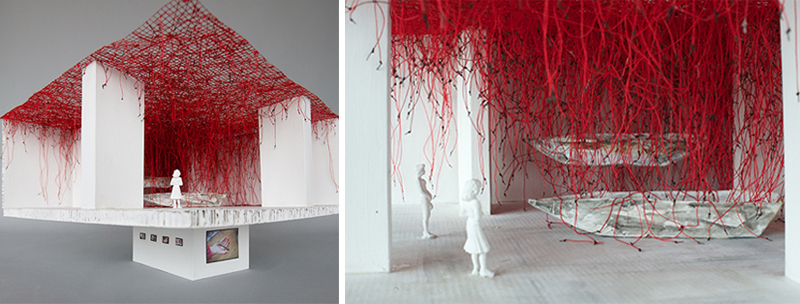
Venice Biennale Model photo (C)Sunhi Mang
Complementing, clashing, and interacting
--Earlier, we talked about the exhibition by Koki Tanaka and curator Mika Kuraya at the last Biennale Japan Pavilion. I think the content at that time was about considering the possibilities and impossibilities that begin with participation and sharing, with a certain calm distance. This time, it seems like we will be forced to think about participation and sharing in a different way.
Shiota: So that means collecting keys from various people and creating an installation?
--That's included. For example, when you express feelings that are related to personal experiences like the ones you talked about today, how do you feel about them being shaped through the possessions of "others"?
Shiota: For me, the act of collecting is because there is something missing inside me. I want to fill that gap. However, when I look at the actual exhibition space and proceed with the creation of the work, I cut off my own emotions and create the flow of the space while thinking as someone else. It can be said that I will look at it with a colder eye, but I hope that it will create a kind of empathy in each form when someone other than me sees it. I usually use black thread in my works, but this time, since it is a "key," I wanted to connect it with a red thread.
<img alt="《Beyond the Continent》The National Museum of Art, Osaka, 2008 Ⓒ Sunhi Mang
"Beyond the Continent" The National Museum of Art, Osaka, 2008 Ⓒ Sunhi Mang
--In the past, you have also created an installation called "Beyond the Continent" in which you collected countless shoes that once belonged to someone and connected them with red wool. Is there a clear difference between using red and black thread?
Shiota: In the case of that work, when you think of shoes, you think of feet. As the title suggests, I naturally chose red thread instead of black.
Nakano: If you think about it, a key and black thread are a bit scary.
-- In Shiota's works using black thread, I feel a sense of severity, as if visualizing the state of objects being tied to something, such as clothing or furniture. However, speaking of fear, I think that the existence of a key can also be associated with a frightening element when you think about the act of "locking" in various ways.
Nakano: I see. But the act of "closing" also has a positive side in the sense that it protects something important. And the most important thing is how to move forward from there.

From Silence, Kanagawa Prefectural Gallery, 2007, Ⓒ Yasushi Nishimura
--The Venice Biennale can be said to be unique in many ways. It is different from a solo exhibition at a museum, and also different from what you experienced at the Setouchi Triennale, where you learn about the people living there and create something while thinking about remaining there. It tends to be talked about as "participating on behalf of Japan," but how do you feel about that?
Shiota: Since it is a place where dozens of countries exhibit in national pavilions, naturally everyone involved will put in effort, and I would be lying if I said I was not conscious of that. However, if I approached it with the idea that "it's the Japan Pavilion" or "I'm Japanese", I'm sure I would fail. I think that the fact that I was selected this time means that my past work has been recognized to some extent, and rather than forcing myself to take on something, I want to approach it as my true self. Ultimately, I intend to prioritize how much of my ability I can exert there.
Nakano: People who create works like Chiharu are especially required to face the exhibition space wherever they go. This time, too, there are various meanings attached to the three letters of "Japan Pavilion", but at the same time, it is important to understand how to perceive the Japan Pavilion as a space and place, and we are focusing on that and discussing it. I also think that artists and curators have a relationship in which they complement each other's visible/invisible, and what they can/cannot do. There is no such thing as a director in art, so this complementary relationship is important there as well.
-- Complementing each other's weaknesses seems to be both stimulating and difficult.
Nakano: It's true that there will be a need to clash. That said, we won't fight (laughs), but we will create an exhibition while interacting with each other. Artists create works, and curators create exhibitions with them. Technical staff will also be involved. In the attempt at "From Silence," spatial art and temporal art were further involved. By the way, when I looked at the plans of other curators in the competition for the Japanese Pavilion in Venice, some of them envisaged collaborations with such performers and artists, which was very interesting. So, in addition to the keyword "connection," I often think about involvement.
--In this competition, there was a proposal for collaboration between the Japanese and Korean pavilions. Can this be interpreted as a willingness to engage with each other while acknowledging the differences and distances between them?
Nakano: That's right. I think the selection result was an evaluation that our proposal was suitable for exhibiting at the Japan Pavilion this time. However, we consulted with each other on Skype almost every night, and as I said earlier, for a while I felt pressure and evil thoughts before the big stage... (wry smile). So I'm honestly happy to have been selected, and now all I have to do is work hard towards the actual event.
Shioda: Actually, I was nominated by another curator for the previous competition, but I was not selected. Looking back now, it was my first experience at that time, and I think I didn't really know what to do. I thought that if something like that happened, I would never be asked again. So this time, when Nakano-san called me, I thought that this was the first and last time that we could propose this stage together. After all those experiences, I am really happy to be able to exhibit in Venice this time. Nakano-san called me early in the morning to tell me that it was decided (laughs).

--Will this plan continue to move forward until the exhibition opens next year?
Nakano: Yes. There will probably be changes. Of course, we will take care of the core parts, but in the end, there are many things you won't know until you try them. I'm sure that will be the case this time too, and no matter how many models you make and simulate, things will change in the process of realizing them. We talked about a lot of things today, but I think there are some things you can only understand by seeing the actual exhibits. That's why I would be happy if you could come and see it in person if possible.
--Thank you for your time today.
Nakano: Then Chiharu, I'll contact you again soon.
Shiota: Yes (laughs). Thank you very much.
<Key collection> We will use your keys for the Biennale artwork. Chiharu Shiota
We are looking for keys to be used in our new work, "Palm of the Key," for the 56th Venice Biennale International Art Exhibition.
Learn more
Related Events
Chiharu Shiota "Maquette" <This event has ended.>
Saturday, August 30, 2014 - Thursday, October 2, 2014
Kenji Taki Gallery (Nagoya)
The exhibition will feature models of works to be exhibited at the 56th Venice Biennale, as well as maquettes of past installations and two-dimensional works, including new works.
http://www.kenjitaki.com/
Opening hours: 11:00-13:00 / 14:00-18:00
Closed on Sundays, Mondays and public holidays
